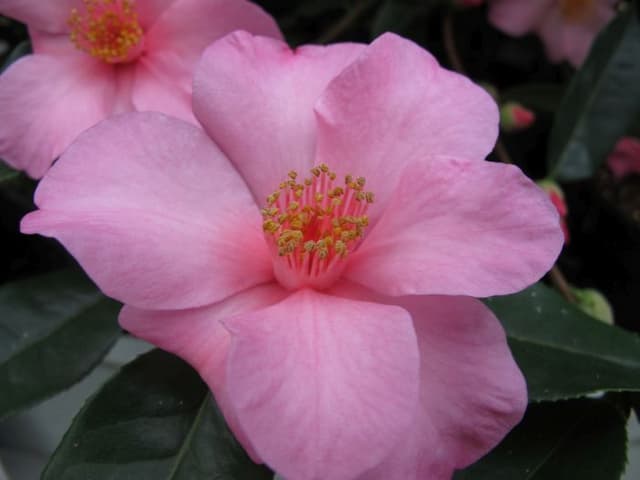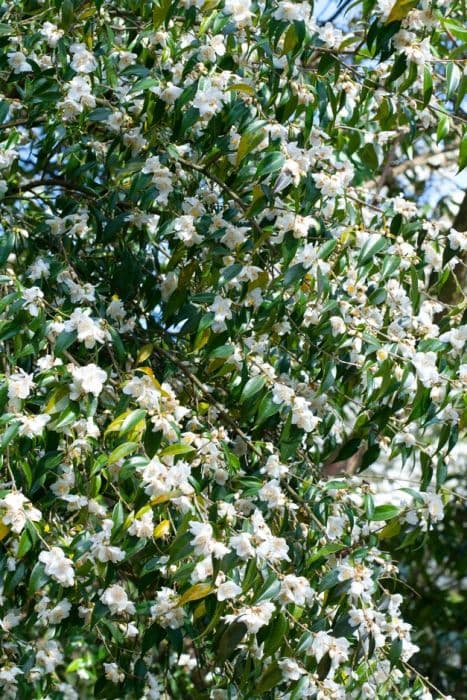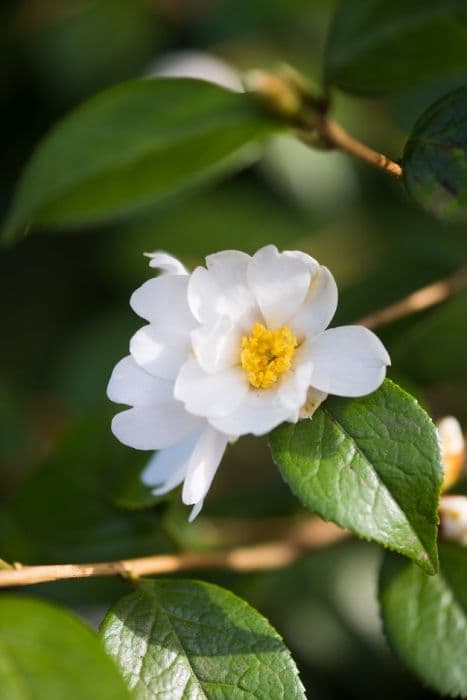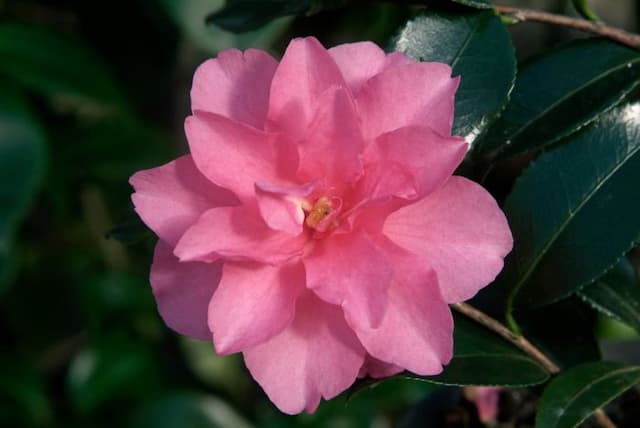Japanese Camellia Camellia japonica 'Lily Pons'

ABOUT
The Camellia japonica 'Lily Pons' is known for its stunning and elegant blossoms. The flowers are typically large and showy, displaying layers of creamy white petals that sometimes are touched with tinges of pale pink, creating a delicate and attractive contrast. These petals have a waxy, glossy texture, adding to their charm and giving them a luxurious feel. At the center of each flower, a cluster of prominent yellow stamens provides a striking focal point that contrasts beautifully against the creamy white of the petals. The foliage of the 'Lily Pons' camellia is equally impressive, composed of glossy, dark green leaves. These leaves are leathery in texture and have serrated edges, presenting a lush background that highlights the brilliance of the flowers. The overall form of the plant is dense and bushy, contributing to its robust and hearty appearance. The combination of exceptional blooms and rich foliage makes this camellia a spectacular specimen in gardens and landscapes, beloved for its year-round visual interest and particularly during its blooming season.
About this plant
 Names
NamesFamily
Theaceae
Synonyms
Japanese Camellia, Rose of Winter
Common names
Camellia japonica 'Lily Pons'.
 Toxicity
ToxicityTo humans
The common name for Camellia japonica 'Lily Pons' is Japanese camellia. Japanese camellia is not considered toxic to humans. Therefore, there are generally no symptoms associated with poisoning because the plant is not known to be poisonous if ingested.
To pets
The common name for Camellia japonica 'Lily Pons' is Japanese camellia. Japanese camellia is also not toxic to pets. Ingesting parts of this plant should not cause any symptoms of poisoning in pets as it is considered non-toxic. However, ingestion of any plant material may cause mild gastrointestinal upset in some pets due to the fiber content or sensitivity, but this is not specific to toxicity.
 Characteristics
CharacteristicsLife cycle
Perennials
Foliage type
Evergreen
Color of leaves
Green
Flower color
White
Height
6-10 feet (1.8-3 meters)
Spread
5-7 feet (1.5-2.1 meters)
Plant type
Shrub
Hardiness zones
7-9
Native area
Japan
Benefits
 General Benefits
General Benefits- Aesthetic Appeal: Camellia japonica, commonly known as Camellia, offers visual interest with its glossy green leaves and large, showy flowers that can enhance any garden landscape.
- Variety of Colors: Camellias come in a wide range of colors, including shades of pink, red, and white, which allows for diverse design options in gardening.
- Year-Round Foliage: Camellias are evergreen, providing a constant backdrop of greenery throughout all seasons, even when not in bloom.
- Drought Tolerance: Once established, Camellias can be quite drought-tolerant, reducing the need for frequent watering and maintenance.
- Shade Tolerance: Camellias can grow successfully in partially shaded areas where other flowers might not thrive, making them versatile for different garden spots.
- Long Blooming Period: Camellias typically have a long flowering period from late winter to early spring, bringing color to the garden when most other plants are dormant.
- Wildlife Habitat: Camellias can provide shelter and food for birds and other wildlife, thereby supporting biodiversity in your garden.
- Privacy Screen: Due to their dense foliage, Camellias can be used as a privacy screen or hedge, offering a natural alternative to fences or walls.
- Soil Erosion Control: The extensive root system of the Camellia can help stabilize soil and prevent erosion, especially in sloped or uneven areas of the garden.
- Resilience: Camellias are resilient and can live for many years with proper care, making them a long-term investment for any gardener.
 Medical Properties
Medical PropertiesThis plant is not used for medical purposes.
 Air-purifying Qualities
Air-purifying QualitiesThis plant is not specifically known for air purifying qualities.
 Other Uses
Other Uses- Ink Production: The petals of Camellia japonica can be used to make a natural dye or ink, which can then be used for arts and crafts, such as fabric dyeing or calligraphy.
- Photography: The vivid flowers of the Camellia japonica can be used as a natural backdrop or subject in macro photography, adding a splash of color and organic beauty to photographs.
- Fish Pond Camouflage: The broad evergreen leaves of the Camellia japonica 'Lily Pons' can be pruned and placed in and around fish ponds to provide natural cover for fish and to blend the pond into the surrounding landscape.
- Pressed Flower Art: The blooms of Camellia japonica can be pressed and preserved to create decorative art pieces or used in scrapbooking for their beauty and texture.
- Wedding Decor: Because of their elegant appearance, the blossoms can be featured in wedding bouquets, centerpieces, or as a natural confetti alternative.
- Candle Making: Petals of the Camellia japonica can be embedded into homemade candles for an attractive floral appearance and slight natural scent.
- Camellia Petal Paths: Dried Camellia petals can be scattered to create natural and fragrant walkways in gardens or for special events.
- Botanical Illustration: Artists and botanists may use the Camellia japonica as a subject for botanical illustration, practicing their skills and capturing the intricate details of the plant.
- Bookmarks: Dried Camellia leaves or petals can be laminated to create beautiful and unique bookmarks.
- Natural Potpourri: The petals of Camellia japonica, especially when dried and perhaps mixed with other botanical elements, can be used to create natural potpourri to fragrance a room.
Interesting Facts
 Feng Shui
Feng ShuiThe Camellia is not used in Feng Shui practice.
 Zodiac Sign Compitability
Zodiac Sign CompitabilityThe Camellia is not used in astrology practice.
 Plant Symbolism
Plant Symbolism- Adoration: Camellia japonica, commonly known as the camellia, is often associated with deep adoration and affection, making it a perfect gift for someone for whom you have strong, positive feelings.
- Perfection and Excellence: The camellia's exquisite beauty and form represent the idea of perfection and excellence, making it an ideal symbol for recognizing someone's outstanding qualities or achievements.
- Long-lasting Devotion: The endurance of the camellia through various seasons signifies long-lasting devotion and steadfastness in relationships, whether romantic or platonic.
- Refined Beauty: Camellias epitomize refined beauty and are often given to convey admiration for someone's elegant and graceful nature.
- Longevity: The camellia is a symbol of longevity due to its ability to live for many years, thus it can represent the wish for a long and healthy life.
 Water
WaterFor the Japanese camellia 'Lily Pons', it is important to maintain moist soil, especially during dry spells, but avoid waterlogging. Water the plant deeply once a week, providing about 1 to 1.5 gallons per watering session, depending on weather conditions and soil drainage. During the hotter months, you may need to water more frequently, ensuring the topsoil doesn't dry out completely. In contrast, reduce the amount of water in the winter when the plant is not actively growing. It's crucial to use a gentle watering method, like a watering can with a spout or soaker hose, to avoid disturbing the roots or eroding the soil.
 Light
LightThe Japanese camellia 'Lily Pons' thrives in partial shade, where it's shielded from the intense afternoon sun. Ideally, situate the plant in a location that receives morning sunlight but is protected during the hotter parts of the day. Dappled shade under tall trees or an east-facing spot that gets filtered morning light is suitable for promoting healthy growth and vibrant blooms.
 Temperature
TemperatureThe Japanese camellia 'Lily Pons' prefers a temperate climate with temperatures ranging from 40 to 85 degrees Fahrenheit. While it can survive temperatures as low as 20 degrees Fahrenheit, long periods of extreme cold can potentially damage the plant. The optimal growing temperature range is between 60 and 70 degrees Fahrenheit, where the camellia can flourish without heat or cold stress.
 Pruning
PruningPruning the Japanese camellia 'Lily Pons' is important for removing dead or weak wood and encouraging vigorous growth and shaping. The best time to prune is just after the blooms have faded, typically in late winter or early spring. Lightly prune to maintain the desired shape and remove any branches that are crossing or growing inward. By pruning annually, you help the camellia to produce more flowers and maintain good health.
 Cleaning
CleaningAs needed
 Soil
SoilThe best soil mix for Japanese camellia 'Lily Pons' should be well-draining, rich in organic matter, and slightly acidic with a pH between 5.5 and 6.5. A recommended mix could be one part peat moss or acidic compost, one part perlite or sand to improve drainage, and one part pine bark to maintain acidity and provide nutrients.
 Repotting
RepottingJapanese camellias like 'Lily Pons' typically require repotting every 2 to 3 years, or when the root system outgrows the current container. It's best to repot in the late winter or early spring before the growing season begins.
 Humidity & Misting
Humidity & MistingJapanese camellia 'Lily Pons' thrives in environments with high humidity, preferably between 50-80%. Consistently moist air helps prevent bud drop and supports healthy leaf and flower growth.
 Suitable locations
Suitable locationsIndoor
Place Japanese camellia 'Lily Pons' in bright, indirect light indoors.
Outdoor
Ensure partial shade, shelter from winds, and mulch for outdoor Japanese camellias.
Hardiness zone
7-9 USDA
 Life cycle
Life cycleCamellia japonica 'Lily Pons', commonly known as the Japanese camellia, begins its life cycle with the germination of seeds, which thrive best when stratified and planted in a well-drained, acidic soil. Seedlings emerge and gradually develop into young plants with glossy, evergreen leaves and begin a slow growth phase that can last for several years before they reach maturity. Once mature, Japanese camellias typically bloom in late winter to early spring, producing large, ornamental flowers that range in color, depending on the cultivar. After pollination, usually by insects, the flowers give way to seed pods which ripen by fall and release seeds to start a new generation. Throughout its life, this perennial shrub undergoes periods of growth and dormancy, adapting to seasonal changes; with proper care, it can live for many decades. Regular pruning after the blooming season helps maintain its shape and promotes the growth of new buds for subsequent years.
 Propogation
PropogationPropogation time
Late winter-early spring
The Camellia japonica 'Lily Pons', commonly known as the Japanese camellia, is most successfully propagated through semi-hardwood cuttings. This technique is usually done in late summer after the current year's growth has begun to mature. To propagate using this method, take a cutting of about 4 to 6 inches long from a healthy branch, making sure it contains at least two to three sets of leaves. Remove the leaves from the bottom half of the cutting and dip the cut end into a rooting hormone to increase the chances of root development. Then plant the cutting in a pot filled with a moist mixture of sand and peat in equal parts, or a well-draining potting mix, and cover it with a plastic bag or place it in a propagator to maintain high humidity. Place the pot in a warm area with indirect sunlight and keep the soil moist but not waterlogged. Roots typically develop in a few weeks to a few months, after which the new plant can be gradually acclimatized to less humid conditions before planting out.









